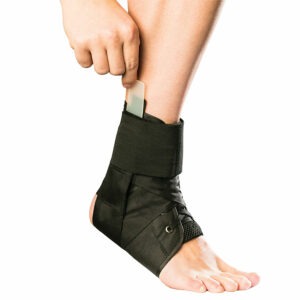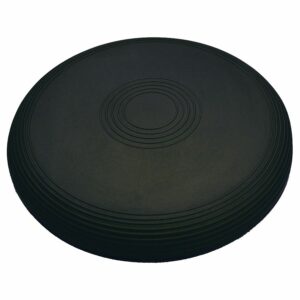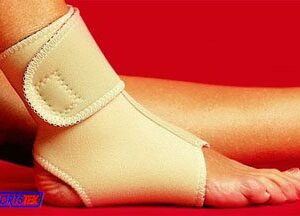Pott’s Fracture
Updated:
(Also known as Broken Ankle, Ankle Fracture, Tibia Fracture, Fibula Fracture, Medial Malleolus Fracture, Lateral Malleolus Fracture, Posterior Malleolus Fracture)
What is a Pott’s fracture?
A Pott’s fracture is a type of ankle fracture that is characterized by a break in one or more bony prominences on the sides of the ankle known as the malleoli (figures 2 & 3).
The lower leg comprises of 2 long bones, known as the tibia and the fibula, which are situated beside each other (figure 1). The tibia bone lies on the inner aspect of the lower leg and joins with the fibula and talus to form the ankle joint (figure 1). The tibia has a bony process situated at the inner aspect of the ankle known as the medial malleolus and one situated at the back of the ankle known as the posterior malleolus (figure 2). Whilst the fibula has a bony process situated at the outer aspect of the ankle known as the lateral malleolus (figure 3).
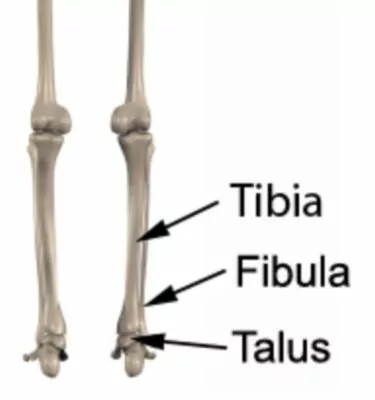
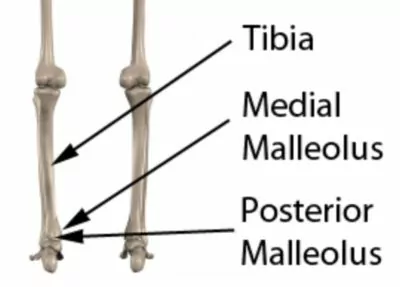
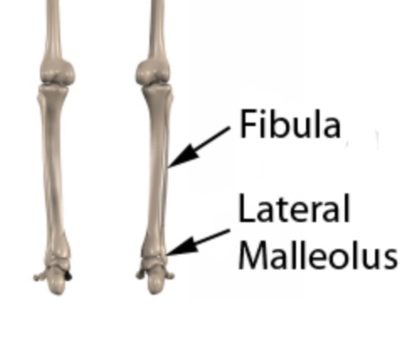
During certain activities such as landing from a jump, or when rolling an ankle, stress is placed on the tibia and fibula. When this stress is traumatic, and beyond what the bone can withstand, a break in the medial, lateral or posterior malleolus may occur. When this happens this condition is known as a Pott’s fracture.
Because of the large forces required to break the tibia or fibula, a Pott’s fracture often occurs in combination with other injuries such as a sprained ankle or other fractures of the foot, ankle or lower leg.
Pott’s fractures can vary in location, severity and type including displaced fractures, un-displaced fractures, bimalleolar fractures, trimalleolar fractures, compound fractures, hairline, spiral, comminuted etc.
Causes of a Pott’s fracture
A Pott’s fracture often occurs in association with a rolled ankle particularly when significant weight bearing forces are involved. They may also occur due to an awkward landing from a jump (particularly on uneven surfaces), due to a fall or following a direct blow to the lower leg or ankle. Pott’s fractures occasionally occur in running and jumping sports involving sudden change of direction such as football, soccer, rugby, basketball and netball.
Signs and symptoms of a Pott’s fracture
Patients with a Pott’s fracture typically experience a sudden onset of sharp, intense ankle or lower leg pain at the time of injury. An audible sound, such as a “crack” or “snap”, may also have been heard. The pain associated with this condition usually causes the patient to limp so as to protect the injury. In severe cases, particularly involving a displaced fracture of one or more malleoli (especially the medial malleolus), weight bearing may be impossible. Depending on the location of the fracture (or fractures), pain may be felt at the front, back, inner or outer aspect of the ankle or lower leg. Occasionally the intense initial pain may settle quickly with rest, leaving patients with an ache at the site of injury that may be particularly prominent at night or first thing in the morning. Occasionally patients may experience symptoms in the Achilles or calf region.
Patients with a Pott’s fracture usually experience swelling, bruising and pain on firmly touching the affected region of bone. Pain may also increase during certain movements of the foot or ankle or when attempting to stand or walk (particularly up hills or on uneven surfaces). In severe Pott’s fractures (with bony displacement), an obvious deformity may be noticeable. Occasionally patients may also experience pins and needles or numbness in the lower leg, foot or ankle.
Diagnosis of a Pott’s fracture
A thorough subjective and objective examination from a physiotherapist or doctor is essential to assist with diagnosis of a Pott’s fracture. An X-ray is required to confirm the diagnosis and assess the severity. Further investigations such as an MRI, CT scan or bone scan may be required, in some cases, to assist with diagnosis and assess the severity of the injury.
Treatment for a Pott’s fracture
For those Pott’s fractures that are displaced or where the normal anatomical relationship of the bones of the ankle has been disrupted, treatment typically involves anatomical reduction (i.e. re-alignment of the fracture by careful manipulation under anaesthetic) followed by surgical internal fixation (using plates and screws) to stabilize the fracture and restore the normal anatomical alignment of the ankle. This may be followed by the use of a protective boot, brace, or, more commonly, a plaster cast, and/or crutches for a number of weeks.
For those fractures that are not displaced and have satisfactory anatomical alignment of the ankle on X-ray, treatment may involve the use of crutches and/or a protective boot or brace, or, plaster cast immobilization and the use of crutches, followed by the use of a protective boot or brace for a number of weeks.
The orthopaedic specialist will advise the patient as to which management is most appropriate based on a number of factors, including the location, severity and type of Pott’s fracture.
Evaluation of the fracture with follow up X-rays is important to ensure the fracture is healing in an ideal position. Once healing is confirmed, rehabilitation can progress as guided by the treating physiotherapist.
One of the most important components of rehabilitation following a Pott’s fracture is that the patient rests sufficiently from any activity that increases their pain (crutches and / or a protective boot are often required). Activities which place large amounts of stress through the ankle should also be avoided, particularly excessive weight bearing activity such as running, jumping, standing or walking excessively (especially up hills or on uneven surfaces). Rest from aggravating activities allows the healing process to take place in the absence of further damage. Once the patient can perform these activities pain free, a gradual return to these activities and weight bearing forces is indicated provided there is no increase in symptoms. This should take place over a period of weeks to months with direction from the treating physiotherapist.
Ignoring symptoms or adopting a ‘no pain, no gain’ attitude is likely to cause further damage and may slow healing or prevent healing of the Pott’s fracture altogether.
Patients with a Pott’s fracture should perform pain-free flexibility, strengthening and balance exercises as part of their rehabilitation to ensure an optimal outcome. This is particularly important, as balance, soft tissue flexibility and strength are quickly lost with inactivity. The treating physiotherapist can advise which exercises are most appropriate for the patient and when they should be commenced.
Hands on treatment from a physiotherapist, involving techniques such as massage and joint mobilisation, is essential to ensure optimal range of movement and flexibility is achieved following injury.
In the final stages of rehabilitation for a Pott’s fracture, a gradual return to activity or sport can occur as guided by the treating physiotherapist provided there is no increase in symptoms.
It may be advised upon returning to some sports, particularly those sports requiring rapid change of direction, such as football and netball, that the ankle is either taped or braced for additional support or protection. The treating physiotherapist can advise if this is recommended.
Prognosis of a Pott’s fracture
In all but the most severe cases of a Pott’s fracture, patients usually make a full recovery with appropriate management (whether surgical or conservative). Return to activity or sport can usually take place in a number of weeks to months and should be guided by the treating physiotherapist and specialist. In patients with severe injuries involving damage to several bones, soft tissue, nerves or blood vessels, recovery time may be significantly prolonged. In patients with only very minor fractures that are un-displaced (such as some avulsion fractures of the lateral malleolus), and with appropriate rehabilitation, return to sport can sometimes occur in as little as 6 – 8 weeks as guided by the treating physiotherapist.
Physiotherapy for a Pott’s fracture
Physiotherapy treatment is vital in all patients with a Pott’s fracture to hasten healing and ensure an optimal outcome. Treatment may comprise:
- soft tissue massage
- joint mobilization
- dry needling
- electrotherapy (e.g. ultrasound)
- taping or bracing
- the use of a protective boot or brace
- the use of crutches
- exercises to improve strength, flexibility and balance
- hydrotherapy
- education
- activity modification
- a graduated return to activity plan
- footwear advice
Other intervention for a Pott’s fracture
Despite appropriate physiotherapy management, some patients with a Pott’s fracture do not improve adequately and may require other intervention. The treating physiotherapist or doctor can advise on the best course of management when this is the case. This may include further investigations such as X-ray, CT scan, MRI or bone scan, periods of plaster cast immobilization or referral to appropriate medical authorities who can advise on any intervention that may be appropriate to improve the Pott’s fracture. Occasionally, patients with fractures that are initially managed without surgical intervention may require surgery to stabilize the fracture and a bone graft to aid fracture healing.
Exercises for a Pott’s fracture
The following exercises are commonly prescribed to patients with a Pott’s fracture following confirmation that the fracture has healed or that pain free mobilization can commence as directed by the surgeon. You should discuss the suitability of these exercises with your physiotherapist prior to beginning them. Generally, they should be performed 3 times daily and only provided they do not cause or increase symptoms.
Foot and Ankle Up and Down
Move your foot and ankle up and down as far as possible and comfortable without pain (figure 4). Repeat 10 – 20 times provided there is no increase in symptoms.
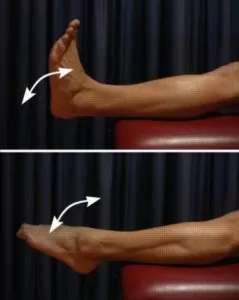
Foot and Ankle In and Out
Move your foot and ankle in and out as far as possible and comfortable without pain (figure 5). Repeat 10 – 20 times provided there is no increase in symptoms.
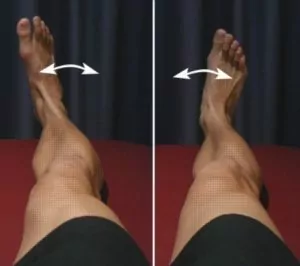
Foot and Ankle Circles
Move your foot and ankle in a circle as large as possible and comfortable without pain (figure 6). Repeat 10 times in each direction provided there is no increase in symptoms.
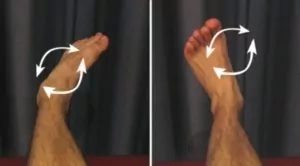
Physiotherapy products for a Pott’s fracture
Some of the most commonly recommended products by physiotherapists to hasten healing and speed recovery in patients with an ankle fracture include:
To purchase physiotherapy products for an ankle fracture click on one of the above links or visit the PhysioAdvisor Shop.
More information
- View more Ankle Stretches.
- View Ankle Strengthening Exercises.
- View Balance Exercises.
- View Ankle Taping Techniques.More information
Find a Physio for a Pott’s fracture
Find a Physiotherapist in your local area who can treat a Pott’s fracture or ankle fracture.
Return to the top of Pott’s Fracture.

Link to this Page
If you would like to link to this article on your website, simply copy the code below and add it to your page:
<a href="https://physioadvisor.com.au/injuries/ankle/potts-fracture”>Pott’s Fracture – PhysioAdvisor.com</a><br/>PhysioAdvisor offers detailed physiotherapy information on a Pott's Fracture including: symptoms, causes, diagnosis, treatment, exercises, physiotherapy products and more...
Return to the top of Pott’s Fracture.

